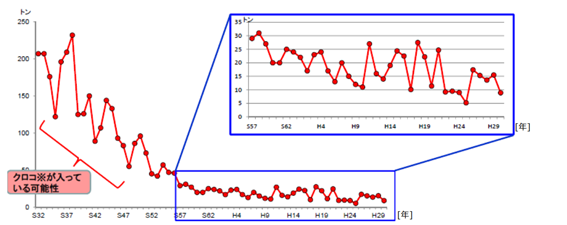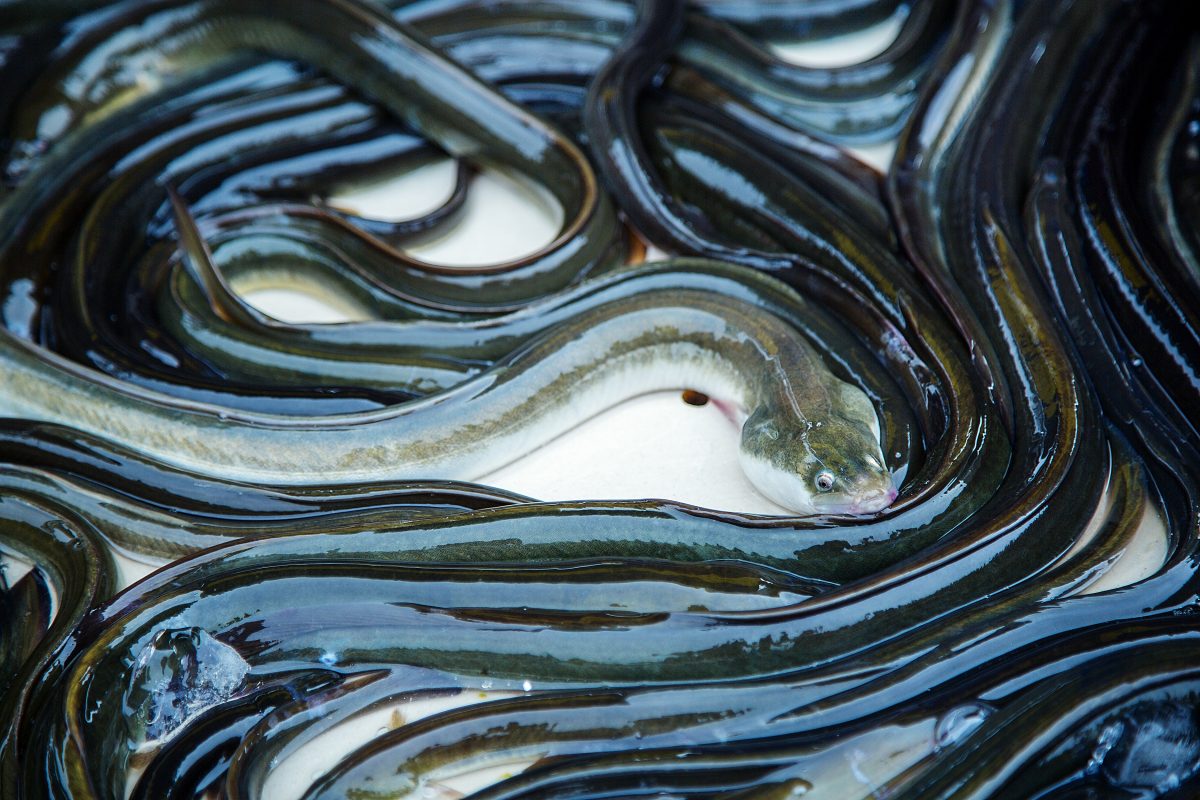Article 2 on the History of the Japanese Eel
Kabayaki eels have been a delicacy in Japanese cuisine for centuries. Prepared in an authentic sauce, the meal is a staple in Japanese culture. However, in recent years Japanese eels have faced environmental pressures that have jeopardized their population and critically decreased their numbers.
The Decline in Eel Populations
As a relatively small and migrating marine species, it is not easy to estimate the population of Japanese eels, and their endangered status. However, there are a number of reasons why we suspect that the populations of eels are on the decrease. Firstly, the glass eel catch has been decreasing constantly since 1960’s (Figure 1, from Japanese Fisheries Agency, S32 is 1957, H29 is 2017, y axis represents metric tons). Furthermore, eel habitats have either been destroyed or are being polluted in Japan and elsewhere in the world. For example, building a dam in the river will prevent the eels from migrating upstream, resulting in reduced habitat area. In addition, construction work such as revetment of rivers and lakes along the coast with concrete embankments have also reduced the number of small animals that eels feed upon.

It is also important to recognize that global warming may have a significant impact on the status of eel’s migration patterns and breeding sites in the deep ocean. The hatched eggs of eels grow into flat, transparent fries called leptocephalus. From their birthplace in the Mariana Trench, leptocephalus migrate north using the ocean current called Kuroshio, or Black Current, to reach East Asia. Any change in the current may affect the migration of the leptocephalus, making it impossible for them to reach their river destinations.
Eel Conservation Status & Initiatives
Currently, European eels are classified as critically endangered (CE) by The International Union for Conservation of Nature (IUCN), while Japanese and American eels are in the endangered (EN) category. Efforts are being made to look for alternative species of eels for commercial use. However, such searches may endanger the non-conventional eel species, unless careful research determines the sustainable limit of the amount of catch. To protect eels from extinction, a variety of initiatives must become top priority. One of the most important is collaboration in achieving the United Nations’ Sustainable Development Goals. This initiative has important implications for the status of eels, like many other endangered life forms.
Complete Eel Aquaculture
Another important development is that of “compete aquaculture” of the eel. This refers to hatching eel eggs in an artificial environment and growing them into leptocephalus and then into glass eels in the lab, instead of catching wild glass eels that may deplete the eel populations,.
In 2018, a Japanese government’s fisheries institute produced glass eels from hatched egg after which hundreds of them were distributed to two commercial eel farms where they matured into adult eels. One of the two companies was Yamada Suisan in Shibushi City in Kagoshima. I had an occasion to observe these eels being raised in an enclosed pond in the Yamada Suisan facility, and I saw perfectly normal and healthy eels there.
In 2019, the mature eels produced by the complete aquaculture process were cooked for tasting and then assessed by participants of this trial. The resulting responses of complete aquaculture were largely favorable, indicating the promise that this method shows for eel production. However, the problem at the moment is low retention rate. Only a small fraction of the hatched eel eggs survive to become glass eels. This may be largely due to the fact that researchers are still unsure of how leptocephali feed. With further research, its very possible that the day will finally come when we can eat eels that never lived in the sea.
Preserving and Protecting Eel Species
Alternatively, if we can produce eel as a cell-based product, this may also do wonders for the protection and conservation of endangered eels. Doing so will also allow us to achieve enhanced efficiency, and more control over the taste. Eel is a good target for cell-based protein, as the consistency of kabayaki can be more easily reproduced than steak meat or sashimi.
Regardless of which method is ultimately pursued, the motives remain the same; it is imperative that we protect eels from overfishing and environmental issues if we are to keep them on our dinner plate. This is the only way that eel lovers in Japan, or around the world for that matter, will be able to enjoy savory unadon every Eel Day.
